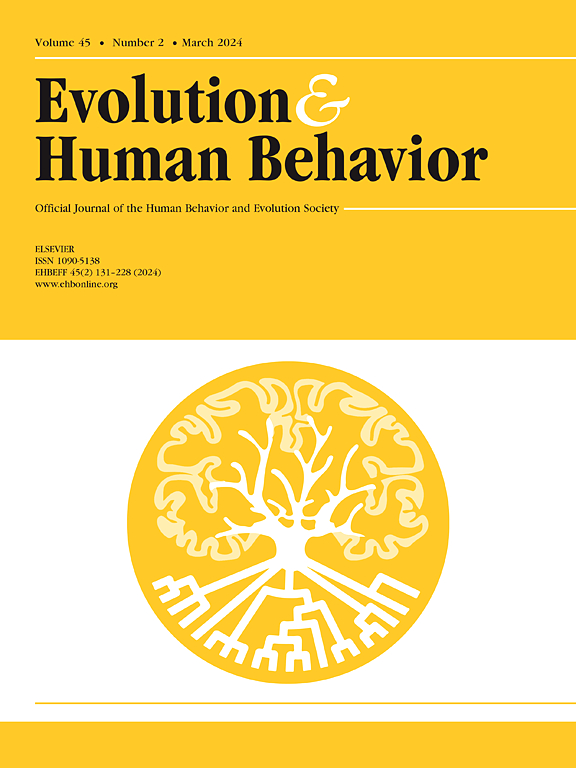Multivariate mate choice constrains mate preference evolution
IF 3.2
1区 心理学
Q1 BEHAVIORAL SCIENCES
引用次数: 0
Abstract
Mate preferences are ideals or standards believed to guide mate choice, which is crucial to an individual's inclusive fitness. In evolutionary psychology, many mate preferences are theorised to have evolved because choosing a partner with the preferred trait offers inclusive fitness benefits. This evolutionary logic assumes that individuals mate with partners whose traits align with their preferences. However, studies often fail to find an association between preferences and actual mate choices. Recent theoretical work suggests that the more preferences used to evaluate potential partners, the weaker this association becomes. These findings raise questions about the conventional view that the large number of observed human mate preferences have evolved independently and simultaneously. Here, we built a computational agent-based model that simulates the evolution of ten traits via natural selection and the resulting evolution of up to ten preferences via sexual selection, varying the number of preferences from one to ten. We developed one model in which preferences evolved through indirect selection and another that added direct selection. Initially, in models with fewer preferences influencing mate choice, preferences evolved visibly alongside preferred traits. However, the more preferences that influenced mate choice, the slower the rate of evolution of preferences. Under the ten-preference model, preferences showed minimal evolution under indirect selection, whereas the addition of direct selection led to more substantial changes, indicating greater robustness to these constraints. Given the numerous mate preferences observed in humans, our findings suggest that we may need to refine some explanations of how these preferences evolved.
多元配偶选择制约着配偶偏好进化
择偶偏好是人们认为指导择偶的理想或标准,这对个体的包容性健康至关重要。在进化心理学中,许多择偶偏好的理论都是进化而来的,因为选择一个具有偏好特征的伴侣会带来全面的健康益处。这种进化逻辑假设,个体与与自己的偏好相一致的伴侣交配。然而,研究往往无法找到偏好与实际择偶之间的联系。最近的理论研究表明,用于评估潜在伴侣的偏好越多,这种联系就越弱。这些发现对传统观点提出了质疑,即大量观察到的人类择偶偏好是独立且同时进化的。在这里,我们建立了一个基于计算主体的模型,该模型模拟了通过自然选择产生的十种特征的进化,以及通过性选择产生的多达十种偏好的进化,偏好的数量从一种到十种不等。我们开发了一个模型,其中偏好通过间接选择进化,另一个模型增加了直接选择。最初,在影响配偶选择的偏好较少的模型中,偏好与偏好特征一起明显进化。然而,影响配偶选择的偏好越多,偏好的进化速度就越慢。在十偏好模型下,间接选择下的偏好变化最小,而直接选择的增加导致了更大的变化,表明这些约束具有更强的鲁棒性。鉴于在人类身上观察到的众多择偶偏好,我们的研究结果表明,我们可能需要完善一些关于这些偏好是如何进化的解释。
本文章由计算机程序翻译,如有差异,请以英文原文为准。
求助全文
约1分钟内获得全文
求助全文
来源期刊

Evolution and Human Behavior
生物-行为科学
CiteScore
8.30
自引率
9.80%
发文量
62
审稿时长
82 days
期刊介绍:
Evolution and Human Behavior is an interdisciplinary journal, presenting research reports and theory in which evolutionary perspectives are brought to bear on the study of human behavior. It is primarily a scientific journal, but submissions from scholars in the humanities are also encouraged. Papers reporting on theoretical and empirical work on other species will be welcome if their relevance to the human animal is apparent.
 求助内容:
求助内容: 应助结果提醒方式:
应助结果提醒方式:


